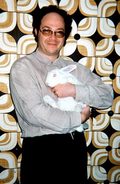
Albo, the GFP Bunny
On first glance, the intersection of art and technology should have a much more complicated boundary than the intersection of art and mathematics, or even art and science. Mathematics and the sciences are relative newcomers in terms of their effect on the arts; available technologies have been used to produce art forever. Here I am using a broad definition of technology as formulated by Edward Tenner, author of Our Own Devices - The Past and Future of Body Technology. For Teller, technology is the "human modification of the natural world" - a definition that encourages us to view fundamental objects such as the shoe, chair, and eyeglasses as transformative technologies.
By extension, then, the technologies of the paintbrush, paints, and perspective -invented to create visual art- are inextricably mixed with art. There really is no boundary.
Until very recently, I didn't believe that the same statement could be made about science and art. What got me thinking was coming across some very provocative art/technology essays in a fascinating journal of art and technology called SWITCH. A production of the CADRE Laboratory for New Media of the School of Art and Design at San Jose State University, SWITCH's goal is to foster "a critical viewpoint on issues and developments in the multiple crossovers between art and technology" with a "main focus on questioning and analyzing as well as reporting and discussing these new art forms as they develop, in hopes of encouraging dialogue and possible collaboration with others who are working and considering similar issues."
Transvergence and Art History, written by Ami Davis, is the article that caused me to reevaluate my position on the science/art interface,or at least on the special opportunities and possibilities that it provides. Transvergence is a new word for me, but one apparently well-defined in the art/technology world. Specifically, Davis focuses not on art history and science:
The term “transvergence” is an invitation to take an opportunity to rethink art history, science, and the inevitably permeable lines that arbitrarily divide these disciplines. Transvergence demonstrates an attitude that the boundaries separating academic disciplines are restrictive. It exposes the artificial construction that art and science are opposites...
According to Davis, transvergence goes well beyond mere interdisciplinarity:
Eduardo and Alba. Click to enlarge Transvergence creates a distinction between art that is interdisciplinary and art that is transdisciplinary. In interdisciplinary pursuits, disciplines collaborate. Scientists and artists, commonly regarded as ideologically opposed practitioners, can intersect and contemplate their common relationships. However, these interacting disciplines ultimately retain their identities as isolated from each other. Transdisciplinary projects also have an agenda to explore common practices among disciplines, but with a more holistic approach. By transcending conventional notions of what appropriate activities within a discipline are, participants attempt to bridge disciplines in innovative ways. The result is that new commonalities are discovered among disciplines, which have implications for future innovative transvergent events.
Davis sees a transvergent event/process/artistic creation as one that chaotically mixes the distinction between art and science. On first reading this, even with Davis' caveats, I thought of transvergence as just interdisciplinarity that works really well - so well that the participants are truly moved to adopt some of the mind-set, and perhaps techniques, of the co-participant.
I wondered, though, whether there wasn't an inescapable asymmetry here - something along the lines of can scientists more readily adopt an artistic stance than an artist can adopt a scientific stance? I recognize that this view is from my privileged physics-chauvinist position. Unfortunately, this view blinded me to some very interesting science/art efforts that really is qualitatively different from interdisciplinarity, and which are truly symmetric in terms of the artist-science contribution.
Davis describes the work of Eduardo Kac, the artist behind Alba, the Green Fluorescent Protein(GFP) Bunny, the most audacious example of what Kac terms transgenic art:
Kac recruited a zoosystemician and scientists to help him breed a rabbit that glows bright green under certain conditions, a result caused by the integration into the breeding process of a green fluorescent gene found in jellyfish. Interested in establishing life invention as art, Kac wished to transcend the boundaries of what science and what art can be...The traditionally established boundaries between art and the science of genetic engineering demonstrated permeability, and new connections between fields were explored, ranging from ethics, biology, aesthetics, and even human-animal relationships. One “product,” the rabbit, was the vessel for the interaction of all these fields of study.
This idea and its implementation is so far beyond my idea of interdisciplinarity; it bears the unmistakeable glowing footprint of transvergence.

 R.A. DiDio
R.A. DiDio